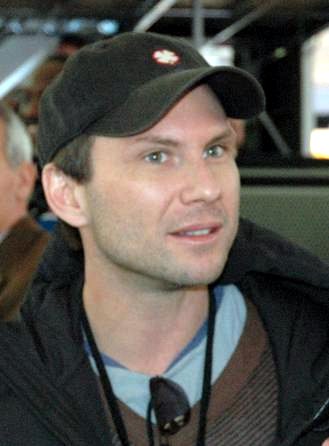
I Was Obsessed With Christian Slater
The following post by Neelanjana Banerjee is part of our online companion to our Winter 2013 issue on Classic Hollywood. Click here for an overview of the issue.
———
In the last two years, Christian Slater, 43, has appeared in nearly 15 films, a couple of forgettable televisions shows, and had several guest voice appearances on the Adult Swim pop-culture extravaganza Robot Chicken—and I’ve seen none of it. I’m guessing most of you haven’t either. It’s like he’s everywhere and nowhere at the same time.
Thinking about Slater nowadays gives me a kind of nauseous vertigo that I suppose is mostly about myself, but a little bit about his horrible choices. I covered my eyes and peeked out intermittently when I recently saw a trailer for Bullet to the Head, in which Slater stars with Sylvester Stallone. The movie is about “a cop and a hit man who form an alliance in order to bring down their common enemy.”
It’s not that I’m embarrassed for him. Slater’s straight-to-VOD career—his only slightly thicker face and acceptably receded hairline—makes him a teen actor success story. He’s alive, working, and we never had to see him try to revive his career with reality television disasters, a la Corey Haim.
But I do have to watch him get old, not quite gracefully, and know that I’m doing the same thing.
Twenty-two years ago, Slater was everywhere, too. I don’t have a first memory of recognizing him, but I loved the Pat Benatar-fueled Legend of Billie Jean (1985) re-runs, in which Slater plays Billie Jean’s younger brother Binx. He was still a kid in this movie, sporting shaggy blonde hair and sleeveless shirts. In fact, he seemed like a regular person, and maybe that’s why I picked him. He was more accessible than the artful River Phoenix and the impossibly golden Johnny Depp. Slater was pale, and plain looking. He reminded me of the white boys I developed painful crushes on in my Ohio elementary school: boys with freckles and dun-colored eyes who sneered at teachers.
Here’s the truth: I made a clenched fists, look-yourself-in-the-mirror promise when I was 12 years old that one day I would have sex with Christian Slater. It was the summer of 1990 and I had a folder stuffed with images I stealthily ripped out of teen magazines I wasn’t allowed to buy from the B. Dalton Bookstore in the mall. I framed one of Slater looking slightly off into the distance from his role as the underground radio jockey in Pump Up the Volume and kept it on my dresser. It was the same summer the movie Ghost came out. I remember because often when “Unchained Melody” would come on the radio, which it did a lot, I would close my door and sing that song to the picture of Slater. Afterwards, I would look in the mirror and promise myself that I had to one day “be with” him.
It was Gleaming the Cube that had sealed the deal for me the year before—a terrible skate thriller set in Orange County concerning Vietnamese anti-communist gun-running. Slater’s performance is underwhelming, but when he cleaned up and courted his dead adopted Vietnamese brother’s girlfriend, Tina Trac, I surrendered some part of myself to him. If Gleaming the Cube hooked me, it was—of course—his over-the-top, Jack Nicholson-channeling performance in Heathers that sunk me completely, as it did for everyone. Slater was 20 years old, with nearly black hair, a trench coat, a ring in one ear, and those irrepressible eyebrows. When he comes to rescue Winona Ryder’s Veronica from cow tipping and date rape, Slater—backlit and with cigarette smoke curling from his nostrils—says: “Sorry, I’m feeling a little superior now. Seven schools in seven states and the only thing different is my locker combination. Our love is god. Let’s go get a slushee.” His vitriol and anti-Ohio rhetoric was exactly what I had been waiting for, and I spent months committing the movie to memory.
These were confusing times for me. I had also recorded about half of The Name of the Rose, which Slater co-starred as novice to Sean Connery’s Franciscan friar, from late-night HBO. I had no interest in the Umberto Eco novel Spanish Inquisition plot, but I was both fascinated and horrified by Slater’s five-minute, graphic sex scene with the “feral” girl, played by Valentina Vargas. Since the only VCR was in the family room, I could only watch the scene when the rest of my family wasn’t home, or sometimes, if my parents had gone to sleep. I would kneel in front of the television, the volume low, and my finger on the VCR/TV button in case someone came in, my heart stuttering. The scene, in which Vargas aggressively seduces Slater, had very little to do with the strip croquet scene in Heathers, and even less to do with the soft-focus, sexy pottery scenes that played in my head when I sang to my picture of Slater. Even at twelve, my thick body bore no resemblance to Vargas’ bony, tiny-breasted visage. As she tries desperately to remove Slater’s burlap cassock, the camera focuses on his strange monk’s bowl haircut with the bald spot shaved in. I was mostly horrified, but couldn’t stop watching it.
After Heathers and Pump Up the Volume, I followed Slater down a rabbit-hole of terrible films. (He never really was very discerning.) I suffered through the Fred Savage, Nintendo commercial The Wizard, Kevin Costner’s Robin Hood: Prince of Thieves, Mobsters, Kuffs, and Young Guns Two. I would wait for Bon Jovi’s “Blaze of Glory” video to come on MTV, so I could catch the two close-ups of Slater.
Predictably, my flame for Slater started to fizzle when I turned fourteen and got a boyfriend. I remember going to see the Marissa Tomei/Slater tearjerker Untamed Heart with a group of friends. My boyfriend and I sat a few rows behind them, and I spent the entire movie kissing him—pressing myself harder and harder against the armrest between us until I thought my ribs were going to break. I don’t think I came up for a breath until Christian Slater’s baboon heart had stopped beating.
By the time True Romance came out later that year, both Slater and I had grown up. The pictures of Slater had long been put away, and instead I spent a lot of time in the smoking section at Denny’s repeating racist monologues from the movie. I would have liked that ending to it all. I wanted my love affair with Slater to end like the end of True Romance, with a beach sunset and both of us, Slater and myself, still young and unbearably cool.
I think that’s what makes me cringe the most when I see Slater now in his terrible everyman roles or playing an aging goofball on talk shows: it reminds me of how far we’ve both come from those burning, lonely moments in my bedroom so many years ago. There was something in that pure, unadulterated desire that I don’t know if I’ve felt again, and sometimes, well, sometimes I miss it.
———
About the author: Neelanjana Banerjee’s fiction, poetry, and essays have appeared in PANK Magazine, The Rumpus, World Literature Today, Nimrod, Colorlines, Fiction Writers Review, HTML Giant and more. She is one of the co-editors of Indivisible: An Anthology of South Asian American Poetry (University of Arkansas Press, 2010). She serves as the media director for Kaya Press, and teaches writing to continuation high school students in Los Angeles.

